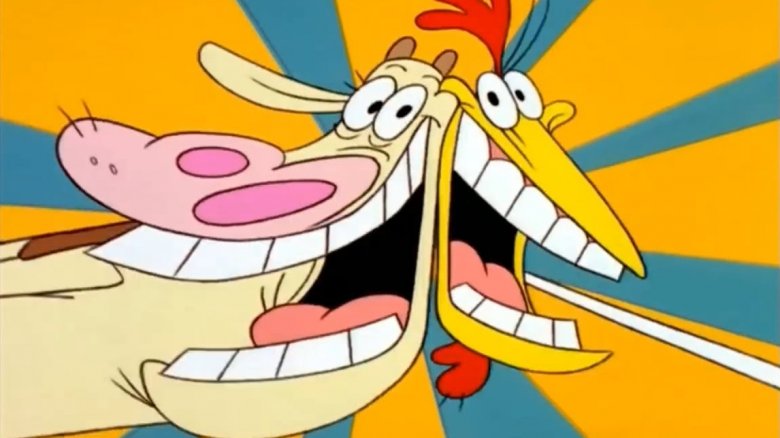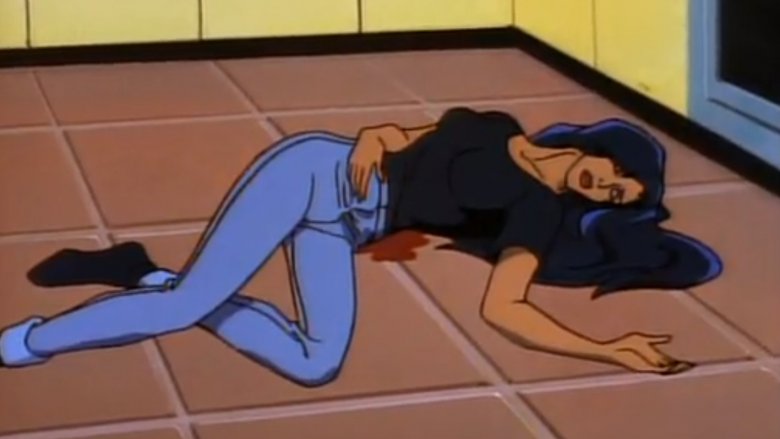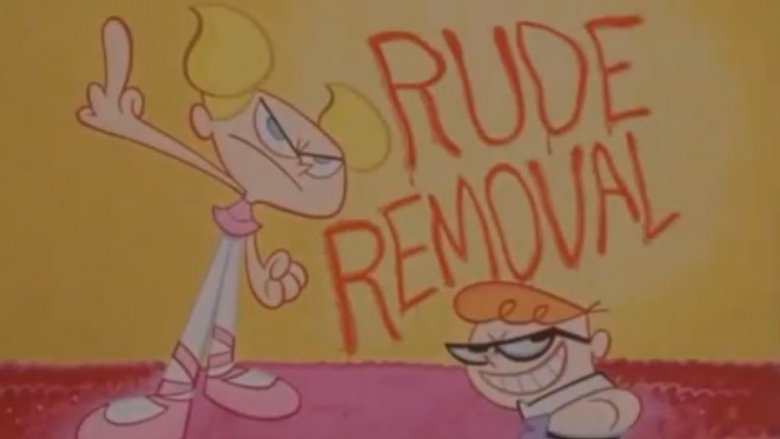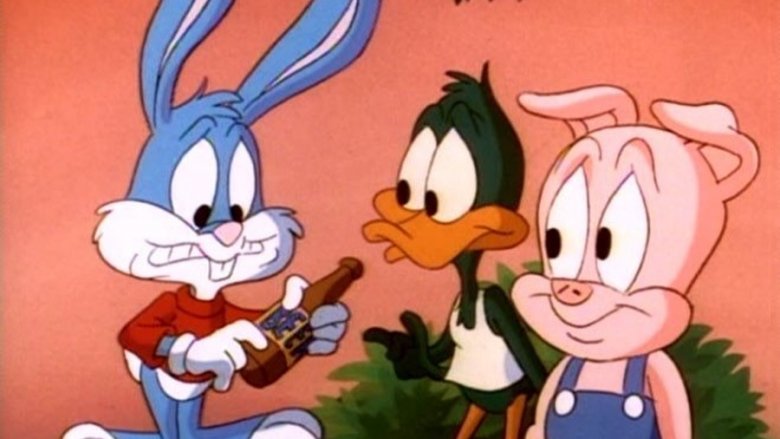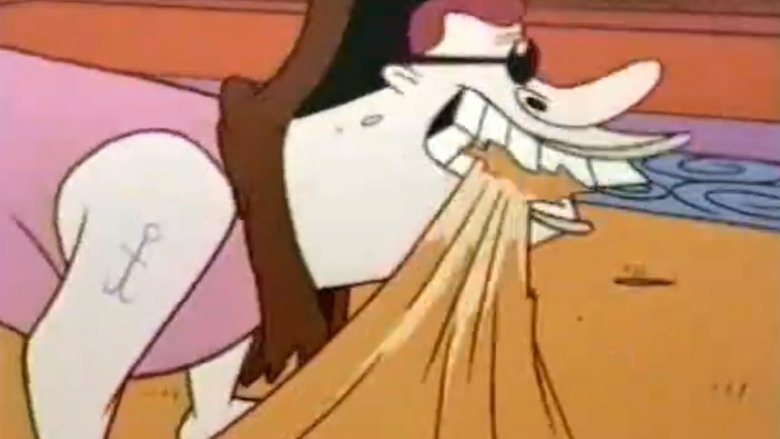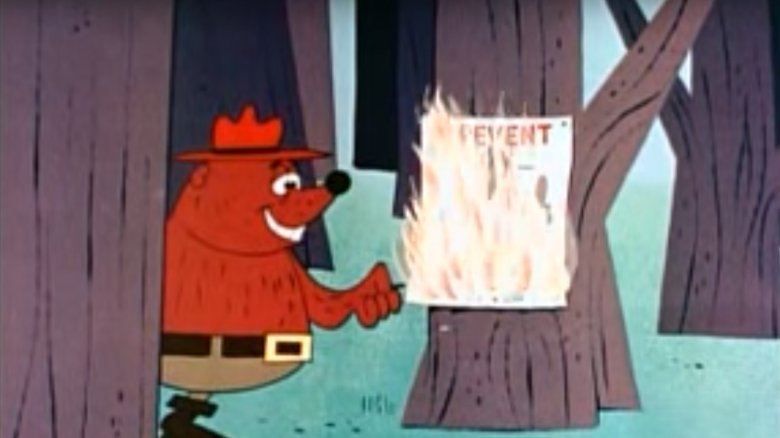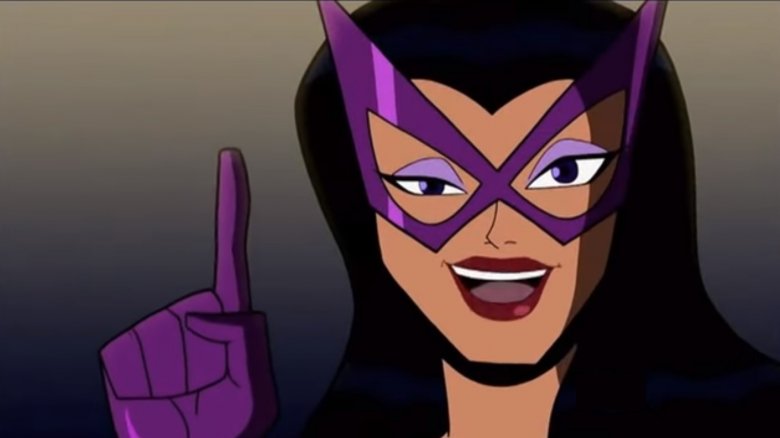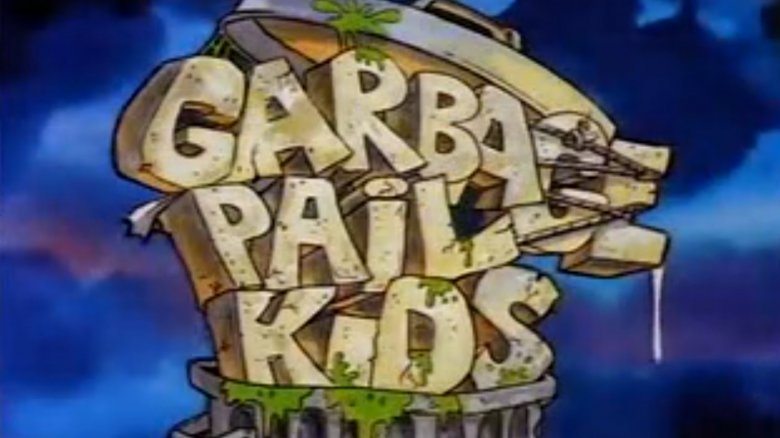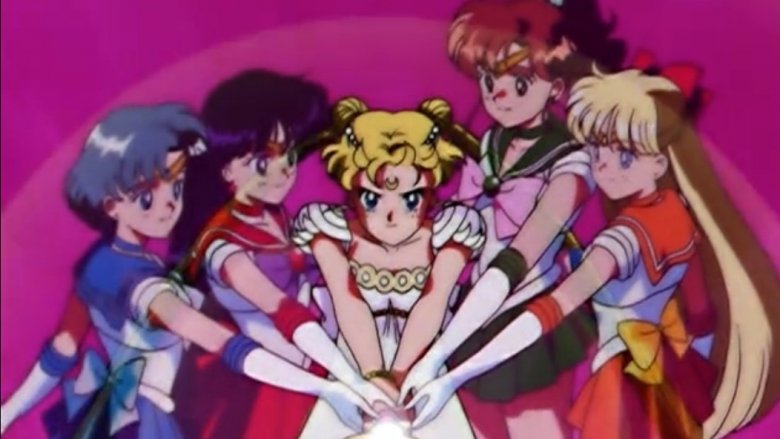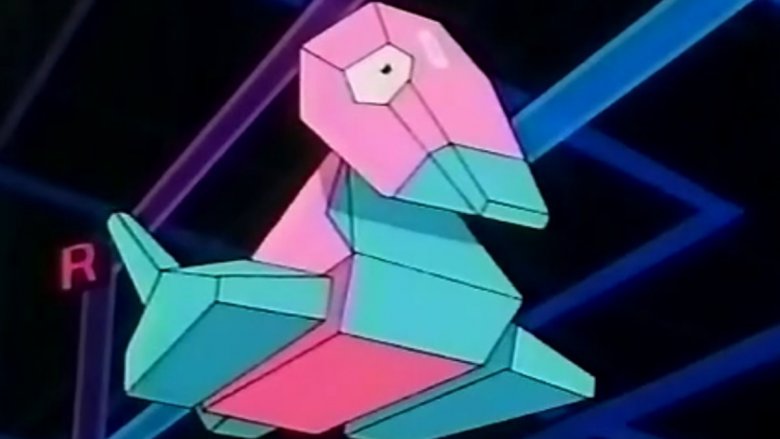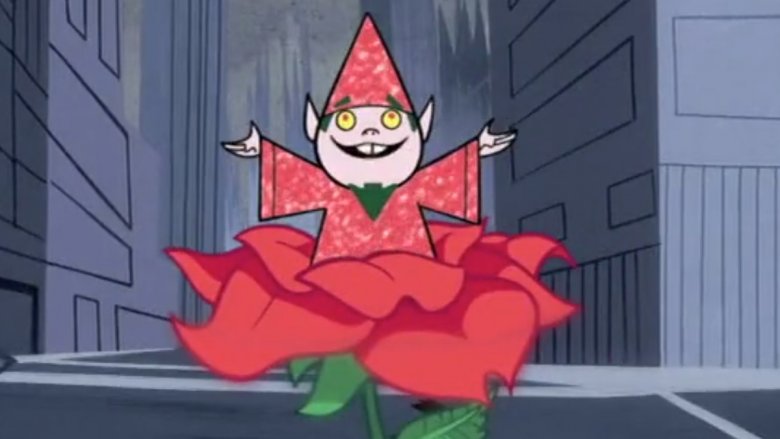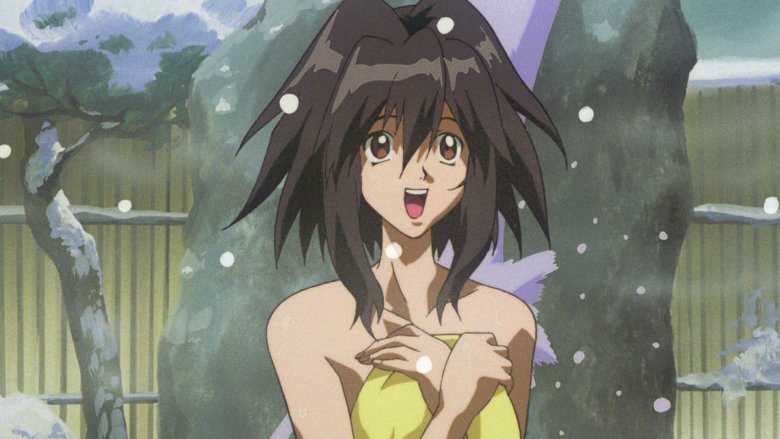Cartoon Episodes So Controversial They Were Banned
Cartoons occupy a deceptively complex part of our culture. They're (largely) for kids, so they can be sillier, weirder, often senseless and even a little bit dumb. Whatever, we say, with a casual shrug — it's kid's stuff. Yet, simultaneously, we are preoccupied with what our children — our impressionable, naive children — are learning from them, especially in the age of the omnipresent screen. These are their youngest years, we say, when they learn everything they'll need to know to have a worthwhile life. We can't just sit them down in front of anything! Arguments rage: Cartoons should be smarter! Cartoons should be simpler! Cartoons should have morals! Cartoons should be funnier!
There will never be an answer that satisfies everyone. But every so often, enough controversy, outrage, and concern can coalesce around an episode or two to merit a ban. Sometimes, in retrospect, we realize these bans wouldn't happen today. Sometimes we marvel at the fact that the cartoon was ever animated in the first place. But banned they were, and it turns out there are enough of them to fill a list: Each of these cartoon episodes were so raunchy, so stupid, or so downright confusing that they were denied an audience entirely.
Gargoyles: Deadly Force
From its 1994 debut, Gargoyles gained a devoted fanbase for its complex plots, fluid animation, and serious storytelling. As an action-adventure series chronicling the lives of gargoyles who come to life at night to protect the places and people they love, the series explored themes including frustrated love, urban crime, and corporate greed. This willingness to go to intense places made Gargoyles an enduring hit that lives on in cosplay and tie-in comics to this day — but in the minds of network executives, it also crossed the line.
The season one episode "Deadly Force" is a compassionate, albeit stern story about gun safety, in which fun-loving gargoyle Broadway accidentally shoots human detective Elisa with her own gun. She is badly wounded and barely survives emergency surgery, and Broadway goes on a frantic, guilt-ridden crusade against guns. Ultimately, a very important lesson is learned about the safe handling of firearms — but not before graphic, blood-splattered frames of Elisa with a bullet in her belly filled the screen. "Deadly Force" was pulled from rotation for a while, and subsequent airings on spinoff channels Toon Disney and Disney XD re-cut the scene so that only Elisa's anguished face is visible. Regardless, the staff remains proud of the message they sent about gun violence in this episode, and stand by it as a thoughtful examination of firearms and their mishandling.
Dexter's Laboratory: Dexter's Rude Removal
Dexter's Lab was one of the biggest successes of 1990s animation, an irreverent send-up of everything from midcentury space-age ambition to Marvel action heroes. At the heart of it was Dexter, megalomaniacal child genius with a secret lab behind his bedroom bookcase, and Dee Dee, his goofy, tutu-clad sister. Their clashes (often involving Dexter's experiments upon Dee Dee) defined many episodes of the show and typically went to bizarre extremes, as when Dexter sought to grow a beard to display his manliness after Dee Dee's teasing, or when Dee Dee inspired a crush in Dexter's arch-nemesis, Mandark.
That sibling rivalry reached new heights in "Dexter's Rude Removal." In this infamous episode, Dexter develops a "rude removal system" to remove Dee Dee's more irritating qualities. This backfires, and Dexter ends up creating two versions of himself and his sister: a polite, vaguely British pair, and a pair whose every other word is censored by profanity bleeps. Despite its completion, "Dexter's Rude Removal" never aired. Series creator Genndy Tartakovsky mentioned it from time to time, growing its legend, until finally, it surfaced on late-night programming block Adult Swim's website. Despite the fact that no curse word is ever actually uttered uncensored, the mere fact of their existence was too much for delicate ears.
Tiny Toon Adventures: One Beer
Tiny Toon Adventures was known for its wry attitude towards cartoon conventions. Babs, Buster, and the rest of the Acme Looniversity gang regularly poked fun at the expectations and tropes of the medium, from subverting slapstick gags involving mallets and banana peels to the contrasting iconic jokesters like Bugs Bunny and Daffy Duck with genteel mortar boards and academic robes as the Looniversity's professors. From the cartoon's setting in a town called "Acme Acres" to character names like "Mary Melody" riffing off Warner Bros.' legendary "Merrie Melodies" cartoons, the whole cartoon rests on a foundation of metatextual ribbing.
But that went a little off the rails with the infamously banned "One Beer." Plucky Duck, Hamton. J. Pig, and Buster Bunny go on a whirlwind bender when they drink (just one!) beer for the first time, quickly plummeting from wide-eyed kids to stubble-chinned lowlifes who slurringly ask their female classmates, "you babes wanna hang?" Despite the fact that Buster opens the escapade by outright saying "in this episode, we're showing the evils of alcohol," and ending it by asking if they can do a "funny episode tomorrow" now that they've lectured the kids, "One Beer" was banned until 2013 when it was finally included in a DVD release. Let that be a lesson to animators across the globe: don't try to teach valuable lessons!
Cow and Chicken: Buffalo Gals
Cow and Chicken never pretended to be anything but crass. Its titular siblings, excitable second-grader Cow and hot-tempered fifth-grader Chicken, regularly got into trouble that made it clear they were there to make kids laugh, not provide moral guardianship. Take, for example, their enemy Red Guy, who might have actually been the devil but was most notable for not wearing pants: Among his many aliases were Officer Pantsoffski, Mrs. Barederriere, Major Wedgie, and NoPants DeLeon. No joke was too crude for this cartoon to indulge.
There was, however, a limit the censors did not want crossed, and Cow and Chicken found it with "Buffalo Gals," seven solid minutes of lesbian jokes. That is, quite frankly, what the episode consists of in its entirety: a motorcycle gang of short-haired, tattooed women who break into the family's home and chew on the carpet. One of them is named "Munch Kelly." There are softball jokes. The "come out tonight" in the song the gang takes their name from is emphasized. Unsurprisingly, it faced resistance from network executives — although it lives on in the sketchier parts of the internet.
Dudley Do-Right: Stokey the Bear
Dudley Do-Right's "Stokey the Bear" was intended in the spirit of fun. Canada is roundly, if kindly parodied in the episode as the home of trees, lumberjacks, the firewood industry and... well, not much else. A man is named "Red Wood." Snidely Whiplash is doing his diabolical deeds to better barbecue his hot dogs. There's a mountain called Upp, and you can bet certain people talk often about "going down" to it. Stokey, the eponymous character, was meant to be very much in this vein: a parody of Smokey of "Only You Can Prevent Forest Fires" fame, but hypnotized by Snidely into setting fires. All in good fun, right?
Wrong. The U.S. Forest Service wasn't too pleased with the spoof of their beloved mascot, in no small part because Smokey was created with a very particular purpose in mind — one the episode was deliberately muddling. Understandable, perhaps, especially given that the episode's final gag implies Stokey was responsible for the Great Chicago Fire of 1871. The episode was yanked, Stokey was snuffed, and it never saw airtime again.
Batman: The Brave and the Bold: The Mask of Matches Malone!
Batman: The Brave and the Bold was a self-conscious tribute and recreation of Silver Age DC Comics: bright, funny, and unabashedly nonsensical. From the retro aesthetic — check out Catwoman's tactical evening gown and the sheer number of tommy guns — to capers with titles like "Invasion of the Secret Santas!," Brave and the Bold was all about having a good and goofy time.
Mostly, this resulted in kid-friendly hijinks of the laser-guns-and-magical-truth-serums variety. But in "The Mask of Matches Malone!," Brave and the Bold got downright naughty. When they're caught sneaking into a nightclub, Huntress, Catwoman, and Black Canary think fast and perform "Birds of Prey," a throwback toe-tapper about the men of the DC universe that stuffs an innuendo into every other line. This ranges from Catwoman purring "what a weapon, what a bang" about Batman, the implication that Green Arrow doesn't always "shoot straight," and a complaint about the Flash being "just too fast." But what got the episode booted off the season 2 DVD collection was the suggestive finger waggle Huntress deploys when discussing Aquaman's "little fish" and how it is "less outrageous." With a bit of reanimation to remove the telltale finger, it was included as a bonus episode on the season 3 DVD, and thus everyone now knows all about the male members of the Justice League and their prowess — on and off the battlefield.
The 1987 Garbage Pail Kids cartoon
Cast your mind back to 1987, and recall the Garbage Pail Kids trading cards. Their success rested entirely upon the fact that they were utterly disgusting little artifacts of childhood grotesquerie — a perfect parody, as was their intention, of the apple-cheeked goodness of the Cabbage Patch Kids. With such characters as Adam Bomb, Oozy Suzy, and Snotwich Sandra, they were pulling no punches when it came to grossing kids out and cracking them up.
But the 1987 Garbage Pail Kids cartoon went too far for the U.S. viewing audience. Starring Split Kit, Clogged Duane, Elliot Mess, Terri Cloth, and Patty Putty, the eponymous kids used their disgusting powers to save the day. Groups including Action for Children's Television and Christian Leaders for Responsible Television protested, however, and the show was yanked from the airwaves mere days before release. Though it did go on to air in other countries, it never saw the light of US viewership. The Garbage Pail Kids were, to be frank, dumped.
Sailor Moon: Day of Destiny
The English-language dub of anime megahit Sailor Moon cut and censored so many things from the original Japanese version, it merits an article unto itself. Many of these changes have become infamous: Sailor Uranus and Sailor Neptune, originally lovers, were changed to "cousins," Zoisite, originally an effeminate gay man, was given a female voice actor, and multiple instances of implied nudity were scrapped. Before many of these now-infamous choices were, made, however, was "Day of Destiny," the finale to season one.
Originally a two-parter, "Day of Destiny" sees Sailor Moon and company storm the evil Queen Beryl's arctic fortress. Her henchman attack, and the battle quickly goes south: Sailors Mercury, Mars, Jupiter, and Venus all die on the ice, and Sailor Moon is forced to fight the supercharged Beryl on her own. Given that the original Japanese title of the first episode is "Death of the Sailor Guardians: The Tragic Final Battle," it is perhaps unsurprising that it was cut, and the finale reduced to one cobbled-together episode for the U.S. market. It does, however, make the moment when the allegedly "captured" Sailor Scouts appear beside Sailor Moon to offer ghostly encouragement a bit confusing for American kids. Regardless, everyone is reborn in both the English and Japanese versions, and the dub went on to make vastly more controversial choices. Compared to Uranus and Neptune's accidental incest, "Day of Destiny" looks tame.
Pokemon: Electric Soldier Porygon
1990s playgrounds the world over found themselves beset by a new fad: It was called Pokemon, and it still has yet to release its grip on young minds. Kids just can't get enough of Pikachu, Bulbasaur, and the gang, from the comics to the games to the anime. But a rumor haunted the franchise early on, mutating as it passed from kid to kid. There was an episode, they whispered, that was banned. It had made some kids sick. No, it had killed a kid! A dozen kids! Hundreds! The internet was in its infancy and no one had ever seen the fabled episode, and so the tales grew unchecked. Even today you might hear a child whisper about a killer episode of Pokemon that no one has ever seen.
Unlike other kid-spread legends, this one really did turn out to be true. "Electric Soldier Porygon" is the episode in question, and it was indeed banned from the airwaves for reasons of public health. Hundreds of Japanese children were rushed to the hospital after it aired in in 1997, suffering from seizures, convulsions and vomiting. It turned out that a brief moment of bright, strobing animation induced this illness and set off a generation's favorite bit of gossip. Twenty years later, it still fascinates us — though luckily, those prone to seizures know to keep well away.
The Powerpuff Girls: See Me, Feel Me, Gnomey
The Powerpuff Girls was never a show content to be normal. The very premise itself — man combines sugar, spice, everything nice, and a mysterious black ooze, creates triplets — is bizarre, and episodes hinged on everything from elaborate Beatles parodies (season three's "Meet the Beat-Alls") to the sinister effects of paste consumption (season one's "Paste Makes Waste"). But in season five's "See Me, Feel Me, Gnomey," this was taken to new heights: in an homage to rock operas like Tommy, the episode is a sung-through musical in which the girls meet a magical gnome who promises to vanquish all evil in exchange for their powers. They take his offer, and he makes Townsville into a cult. Eventually, the day is saved, Townsville is restored, and the gnome is defeated.
So why did Cartoon Network keep this episode off U.S. airwaves? Questions swirled for years until show creator Craig McCracken finally provided some answers via his Tumblr: "They banned it because they claimed that the metal beams in the destroyed buildings looked too much like crosses and one of the hippies looked like Jesus." The staff was surprised and the fans were deprived, but it all worked out in the end: the episode is now available to anyone who wants to watch it on Hulu, iTunes, or on the original series DVDs.
Outlaw Star: Hot Springs Planet Tenrei
Anime exploded in popularity in the late 1990s, and Toonami, a Cartoon Network programming block aimed at the action-hungry after-school crowd, was a huge part of why. From Sailor Moon to Dragon Ball Z, Toonami aired the coolest, edgiest, often weirdest cartoons Western kids had ever seen — and it kept them coming. New episodes appeared daily, movie-length specials were hyped for weeks prior to airing, and sometimes, occasionally, Toonami even pushed the boundaries of what was considered acceptable. Action was tougher, faster, and more intense on Toonami, and jokes were a bit more edgy.
Outlaw Star, a spacefaring action series, often pushed that line. But one whole episode, "Hot Springs Planet Tenrei," was deemed unacceptable, impossible to edit into suitability, and unceremoniously dumped. It's no surprise as to why: "Hot Springs Planet Tenrei" sees hero Gene Starwind sent to world of beautiful saunas filled with even-more-beautiful — and always unclothed — ladies. Editing a topless shot here and there was doable, but this episode was simply too dependent on many, many scenes full of flesh. In the end, kiddie viewers just had to deal with the lack of continuity — until, many years later, it aired on the late-night reimagined Toonami, intended for just those kids who'd loved it the first time around.
